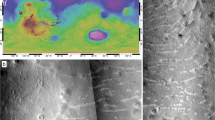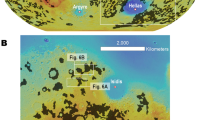Abstract
Mars Exploration Rover Opportunity discovered sediments with layered structures thought to be unique to aqueous deposition and with minerals attributed to evaporation of an acidic salty sea. Remarkable iron-rich spherules were ascribed to later groundwater alteration, and the inferred abundance of water reinforced optimism that Mars was once habitable. The layered structures, however, are not unique to water deposition, and the scenario encounters difficulties in accounting for highly soluble salts admixed with less soluble salts, the lack of clay minerals from acid–rock reactions, high sphericity and near-uniform sizes of the spherules and the absence of a basin boundary. Here we present a simple alternative explanation involving deposition from a ground-hugging turbulent flow of rock fragments, salts, sulphides, brines and ice produced by meteorite impact. Subsequent weathering by intergranular water films can account for all of the features observed without invoking shallow seas, lakes or near-surface aquifers. Layered sequences observed elsewhere on heavily cratered Mars and attributed to wind, water or volcanism may well have formed similarly. If so, the search for past life on Mars should be reassessed accordingly.
This is a preview of subscription content, access via your institution
Access options
Subscribe to this journal
Receive 51 print issues and online access
$199.00 per year
only $3.90 per issue
Buy this article
- Purchase on Springer Link
- Instant access to full article PDF
Prices may be subject to local taxes which are calculated during checkout





Similar content being viewed by others
References
Squyres, S. W. et al. The Opportunity Rover's Athena science investigation at Meridiani Planum, Mars. Science 306, 1698–1703 (2004)
Squyres, S. W. et al. In situ evidence for an ancient aqueous environment at Meridiani Planum, Mars. Science 306, 1709–1714 (2004)
Christensen, P. R. et al. Mineralogy at Meridiani Planum from the Mini-TES experiment on the Opportunity rover. Science 306, 1733–1739 (2004)
Kerr, R. A. On Mars, a second chance for life. Science 306, 2010–2012 (2004)
Carlson, R. H. & Roberts, W. A. Ejecta Studies, Project Sedan (PNE-217P, University of California Lawrence Radiation Laboratory, Livermore, California, 1962)
Glasstone, S. & Dolan, P. J. The Effects of Nuclear Weapons 3rd edn (US Department of Defense and Energy Research and Development Administration, Washington DC, 1977)
Wohletz, K. H. in Developments in Volcanology, from Magma to Tephra, Modelling Physical Processes of Explosive Volcanic Eruptions (eds Freundt, A. & Rosi, M.) 247–312 (Elsevier, Amsterdam, 1998)
Melosh, H. J. Impact Cratering (Oxford University Press, New York, 1989)
Dressler, B. O., Sharpton, V. L., Schwandt, C. S. & Ames, D. Impactites of the Yaxcopoil-1 drilling site, Chicxulub impact structure: Petrography, geochemistry, and depositional environment. Meteorit. Planet. Sci. 39, 857–878 (2004)
Oberbeck, V. R. The role of ballistic erosion and sedimentation in lunar stratigraphy. Rev. Geophys. Space Phys. 13, 337–362 (1975)
Schultz, P. H. & Gault, D. E. Atmospheric effects on Martian ejecta emplacements. J. Geophys. Res. 84, 7669–7687 (1979)
Carr, M. H. et al. Martian impact craters and emplacement of ejecta by surface flow. J. Geophys. Res. 82, 4055–4065 (1977)
Osinski, G. R., Grieve, R. A. F. & Spray, J. G. The nature of the groundmass of surficial suevite from the Ries impact structure, Germany, and constraints on its origin. Meteorit. Planet. Sci. 39, 1655–1683 (2004)
Wohletz, K. H. & Sheridan, M. F. Martian rampart crater ejecta: Experiments and analysis of melt-water interaction. Icarus 56, 15–37 (1983)
Knauth, L. P. & Burt, D. M. Eutectic brines on Mars: Origin and possible relation of young seepage features. Icarus 158, 267–271 (2002)
McGetchin, T. R., Settle, M. & Head, J. W. Radial thickness variation in impact crater ejecta: Implications for lunar basin deposits. Earth Planet. Sci. Lett. 20, 226–236 (1973)
Garvin, J. B., Sakimoto, S. E. H., Frawley, J. J. & Schnetzler, C. Global geometric properties of Martian impact craters. Lunar Planet. Sci. 33, abstr. 1255 (2002)
Sheridan, M. F. & Wohletz, K. H. in Microbeam Analysis (ed. Gooley, R.) 35–38 (Univ. San Francisco Press, San Francisco, 1983)
Kieffer, S. W. & Simonds, C. H. The role of volatiles and lithology in the impact cratering process. Rev. Geophys. Space Phys. 18, 143–181 (1980)
Valentine, G. A., Buesch, D. & Fisher, R. V. Basal layered deposits of the Peach Springs Tuff, northwestern Arizona, USA. Bull. Volcanol. 51, 395–414 (1983)
Mitchell, D. E., Sakimoto, S. E. H. & Garvin, J. B. MOLA topography and morphometry of rampart and pedestal craters, Mars. Lunar Planet. Sci. 33, abstr. 1805 (2002)
Melosh, H. J. Impact ejecta sedimentation processes in the atmosphere and ocean. Meteorit. Planet. Sci. 39, abstr. 67 (2004)
Fisher, R. V. & Walters, A. C. Base-surge bed forms in maar volcanoes. Am. J. Sci. 268, 157–180 (1970)
Fisher, R. V. & Schmincke, H.-U. Pyroclastic Rocks 249–256 (Springer, New York, 1984)
Hunt, C. B., Robinson, T. W., Bowles, W. A., Washburn, A. L. & Hunt, C. Hydrologic Basin, Death Valley, California (Professional Paper 494-B, US Geological Survey, Washington DC, 1966)
Bullock, M. A. & Moore, J. M. Aqueous alteration of Mars-analog rocks under an acidic atmosphere. Geophys. Res. Lett. 31, L14701, doi:10.1029/2004GL019980 (2004)
Golombek, M. P. et al. Selection of the Mars Exploration Rover landing sites. J. Geophys. Res. 108, 8072, doi:10.1029/2003JE002074 (2003)
Baker, V. R. Water and the Martian landscape. Nature 412, 228–236 (2001)
Jakosky, B. M. & Phillips, R. J. Mars' volatile and climate history. Nature 412, 237–244 (2001)
Burt, D. M. & Knauth, L. P. Electrically conducting, Ca-rich brines, rather than water, expected in the Martian subsurface. J. Geophys. Res. 108, 8026, doi:10.1029/2002JE001862 (2003)
Christensen, P. R. & Ruff, S. W. Formation of the hematite-bearing unit in Meridiani Planum: Evidence for deposition in standing water. J. Geophys. Res. 109, EO8003, doi:10.1029/2003JE002233 (2004)
Hynek, B. M., Arvidson, R. E. & Phillips, R. J. Geologic setting and origin of Terra Meridiani hematite deposit on Mars. J. Geophys. Res. 107, 5088, doi:10.1029/2002JE001891 (2002)
Boistelle, R. & Astier, J. P. Crystallization mechanisms in solution. J. Cryst. Growth 90, 14–30 (1988)
Chan, M. A., Breitler, B., Parry, W. T., Ormo, J. & Komatsu, G. A possible terrestrial analogue for haematite concretions on Mars. Nature 429, 731–734 (2004)
Graup, G. Terrestrial chondrules, glass spherules and accretionary lapilli from the suevite, Ries Crater, Germany. Earth Planet. Sci. Lett. 55, 407–418 (1981)
Bohor, B. F. & Glass, B. P. Origin and diagenesis of K/T impact spherules—From Haiti to Wyoming and beyond. Meteoritics 30, 182–198 (1995)
Schumacher, R. & Schmincke, H.-U. Models for the origin of accretionary lapilli. Bull. Volcanol. 56, 626–639 (1995)
Catling, D. C. & Moore, J. M. The nature of coarse-grained crystalline hematite and its implications for the early environment of Mars. Icarus 165, 277–300 (2003)
Wohletz, K. H. & McQueen, R. G. Volcanic and stratospheric dust-like particles produced by experimental water-melt interactions. Geology 12, 591–594 (1984)
Lowe, D. R. et al. Characteristics, origin, and interpretation of Archean impact-produced spherule beds, 3.47–3.22 Ga, in the Barberton Greenstone Belt, South Africa: Keys to the role of large impacts on the evolution of the early Earth. Astrobiology 3, 7–48 (2003)
Brueckner, J. et al. Hematite on the surface of Meridiani Planum and Gusev Crater. Lunar Planet. Sci. 36, abstr. 1767 (2005)
Klingelhofer, G. et al. Jarosite and hematite at Meridiani Planum from Opportunity's Moessbauer spectrometer. Science 306, 1740–1745 (2004)
Ditrizac, J. E. & Jambor, J. L. Jarosites and their application in hydrometallurgy. Rev. Mineral. Geochem. 40, 405–452 (2000)
Burns, R. G. & Fisher, D. S. Evolution of sulfide mineralization on Mars. J. Geophys. Res. 95, 14169–14173 (1990)
Cas, R. A. F. & Wright, J. V. Volcanic Successions Modern and Ancient (Chapman & Hall, London, 1987)
McPhie, J., Walker, G. P. L. & Christiansen, R. L. Phreatomagmatic and phreatic fall and surge deposits from explosions at Kilauea volcano, Hawaii, 1790 A.D. Bull. Volcanol. 52, 334–354 (1990)
Golombek, M. P. et al. Climate change from the Mars Exploration Rover landing sites: From wet in the Noachian to dry and desicating since the Hesperian. Lunar Planet. Sci. 36, abstr. 1539 (2005)
Gendrin, A. et al. Sulfates in Martian layered terrains: The OMEGA/Mars Express view. Science 307, 1587–1591 (2005)
Knauth, L. P., Brilli, M. & Klonowski, S. Isotope geochemistry of caliche on basalt. Geochim. Cosmochim. Acta 67, 185–195 (2003)
Lowe, D. R. & Knauth, L. P. The oldest marine carbonate ooids reinterpreted as volcanic accretionary lapilli, Onverwacht Group, South Africa. J. Sedim. Petrol. 48, 709–722 (1978)
Acknowledgements
L.P.K. is supported by the NASA Exobiology Program. We thank C. Moore for supplying the iron condensation spherules from Meteor crater, and G. R. Osinski for comments on an early version of the manuscript. Author Contributions All authors contributed equally to the ideas and interpretations. L.P.K. wrote the initial draft and managed revisions.
Author information
Authors and Affiliations
Corresponding author
Ethics declarations
Competing interests
Reprints and permissions information is available at npg.nature.com/reprintsandpermissions. The authors declare no competing financial interests.
Rights and permissions
About this article
Cite this article
Knauth, L., Burt, D. & Wohletz, K. Impact origin of sediments at the Opportunity landing site on Mars. Nature 438, 1123–1128 (2005). https://doi.org/10.1038/nature04383
Received:
Accepted:
Issue Date:
DOI: https://doi.org/10.1038/nature04383
This article is cited by
-
Renaissance for magnetotactic bacteria in astrobiology
The ISME Journal (2023)
-
Geochemical Reservoirs and Timing of Sulfur Cycling on Mars
Space Science Reviews (2013)
-
Origin of acidic surface waters and the evolution of atmospheric chemistry on early Mars
Nature Geoscience (2010)
-
Meridiani Planum sediments on Mars formed through weathering in massive ice deposits
Nature Geoscience (2009)
-
Ancient equatorial ice on Mars?
Nature Geoscience (2009)
Comments
By submitting a comment you agree to abide by our Terms and Community Guidelines. If you find something abusive or that does not comply with our terms or guidelines please flag it as inappropriate.



